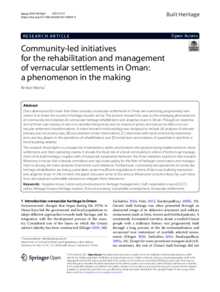وثيقة
Vernacular architecture in Oman : a case study of transition from wood to cement.
المعرف
DOI: 10.1201/b15685
المساهمون
الناشر
CRC Press.
ميلادي
2009-09
اللغة
الأنجليزية
الموضوع
الملخص الإنجليزي
The Al Batina coastal plain extends to the west of the cities of Muscat and Mutrah. This paper is base on an architectural, social and agricultural survey of this rural area, made in the 1970s, when the Sultanate of Oman was suddenly opened to the outside world. It is particularly focused on the "Saaf ", a house built with palm stems and acacia wooden poles. They were compared to other nearby vernacular masonry buildings. This research also studied new vernacular dwellings constructed by the same population in the same area. They would be called "Smeet " houses as they would be built with cement blocks and concrete, painted in white with a brightly coloured decoration. This heritage demonstrates remarkable harmony and inventiveness is worthwhile mentioning in terms of proportions, details and colours. Even if the urban sprawl has finally reached that area, such a case study may illustrate the strength of traditional vernacular models and their ability sometime to adapt when swift transitions occur.
المجموعة
ردمك
978-148222909-7;978-113800083-4
URL المصدر
قالب العنصر
كتب


